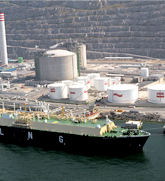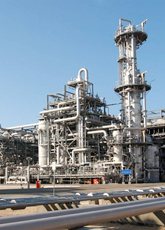Gas in Spain
>
Investments and activities by companies
Investments and activities by companies
Enagas
New assets
Last year, the most important assets operated by Enagás were the increase in the emission capacity of the Huelva plant to 1,350,000 m3/h and the second section of the Falces-Irurzun gas pipeline.
Project under construction:
At the unloading and regasification plant of Cartagena, the fourth tank is being built and the emission capacity is being increased to 1.35 million m3/h.
The gas pipelines also under construction include the following:
The gas pipelines also under construction include the following:
- Duplication of the Barcelona-Tivisa pipeline (Barcelona-Arbós section).
- Semi-ring pipeline of southwest Madrid (phases II and III).
- Transversal axis, which is to connect the north-south axis with eastern Spain.
- Branchline to Campo de Gibraltar (phase II).
New licences:
Enagás also obtained the administrative licence for the operation of the Yela storage
area in Guadalajara, one of the largest investments of the coming years aimed at increasing the safety
of the Spanish gas system.
Similarly, the agreement signed in December by and between Enagás and two companies with action rights in the Castor project, an underground storage area that is to be finally carried out in eastern Spain, is also to go ahead.
This company was also awarded the administrative authorisation for building the underwater gas pipeline that is to connect the peninsular with the Balearic Islands. The underwater section will have a length of 268 km, with an investment of €360 million. The investment of the project totals €490 million and, besides the underwater gas pipeline, includes a land pipeline between Montesa and Denia and a compression station.
The laying of the underwater pipe will begin once the same activity has been completed on the Medgaz pipeline through the Straits of Gibraltar. The latter is to begin during the second week of February 2008.
Similarly, the agreement signed in December by and between Enagás and two companies with action rights in the Castor project, an underground storage area that is to be finally carried out in eastern Spain, is also to go ahead.
This company was also awarded the administrative authorisation for building the underwater gas pipeline that is to connect the peninsular with the Balearic Islands. The underwater section will have a length of 268 km, with an investment of €360 million. The investment of the project totals €490 million and, besides the underwater gas pipeline, includes a land pipeline between Montesa and Denia and a compression station.
The laying of the underwater pipe will begin once the same activity has been completed on the Medgaz pipeline through the Straits of Gibraltar. The latter is to begin during the second week of February 2008.
Medgaz gas pipeline
With regard to the Medgaz pipeline, which will stretch from a compression
station located in Beni Saf, Algeria to the reception terminal in Almería, Spain
over a length of 210 km, it must be pointed out that according to current forecasts, the first
gas shipment will be received halfway through 2009. It is to have an annual capacity of 8 bcm and a diameter of 24".
Furthermore, it will be laid at a maximum depth of 2,160 m. The company Cepsa is the main developer of the project.
Other relevant projects
Enagás plans to build a gas pipeline between Galicia (Guitiriz) and Madrid (Algete), with a total
length of 550 km. It is a pipeline of great importance for increasing the Galician supply safety and
the flexibility of the Spanish gas system. It is mentioned in the draft of the official document titled
Gas and electricity sector planning 2007-2016, which the Spanish government is to adopt during the
coming months.
The said document, which has not yet been approved, includes the construction of a new terminal at the port of El Musel in Gijón, Asturias. This is to be the seventh unloading and regasification plant in Spain.
The said document, which has not yet been approved, includes the construction of a new terminal at the port of El Musel in Gijón, Asturias. This is to be the seventh unloading and regasification plant in Spain.
Practical issues
On a practical level, by virtue of the application of Act 12/2007 (which modifies the Hydrocarbons Act to adapt it
to the second Directive indicated above), Enagás has created a specific organic unit to act as the
Technical Manager of the Gas System, with accounts and functions that are separate from the company itself.
This Act also lays down the impossibility of any individual or body corporate taking part in the capital ownership of Enagás in a proportion of more than 5% of the share capital, limiting the decision rights on the Board to 3% in all cases. Furthermore, the companies that carry out activities in the gas sector will not be able to exercise political rights in the said company of over 1%.
In 2007, Naturgas Energía Transporte began the duplication of the Bergara-Irún pipeline, which is to strengthen the transport of natural gas to the industrial zone of Guipúzcoa and the "bidirectional" international connection of the Euskadour pipeline, which connects Spain with France. This project has been divided into three phases: Bergara-Zaldibia, Zaldibia-Billabona and Billabona-Irún. The start-up is planned for the months of June in the years 2008, 2009 and 2010, respectively.
Transportista Regional del Gas was successful in its bid for the gas pipeline between Cuéllar and Valverde del Majano (province of Segovia) in October 2007. This infrastructure will come into operation in 2009 and is to satisfy the demand from 11 municipal districts.
REGANOSA.In May 2007, the first ship docked at the last Spanish terminal to come into operation (the terminal of REGANOSA) on the estuary of Ferrol in Galicia. Two months before the said date, the Northern pipeline (Mugardos-As Pontes-Guitiriz) had been started up and is now supplying the market with the unloaded gas.
SAGGAS. In February 2007, the Sagunto plant completed one year since the arrival of the first LNG ship. In May 2007, the regasification plant received its 100th LNG ship. The plant is currently being extended with the construction of a third tank with a capacity of 150,000 m3 and a fifth vaporiser that will increase the plant's emission capacity to 1 million m3 per hour. This fifth vaporiser is scheduled to come into operation in 2008 and the third tank in 2009.
 BAHÍA DE BIZKAIA GAS. Besides the last two plants we have referred to the third terminal that is not owned by Enagás is Bahía de Bizkaia Gas. In 2007, it
received 54 ships with a total of 6.6 million m3 of LNG.
BAHÍA DE BIZKAIA GAS. Besides the last two plants we have referred to the third terminal that is not owned by Enagás is Bahía de Bizkaia Gas. In 2007, it
received 54 ships with a total of 6.6 million m3 of LNG.
GAS NATURAL. This company holds the highest share of the market. During the third quarter, the Gas Natural Group reached the figure of 2 million clients in Catalonia and currently has more than 5 million clients in Ibero-America, where it is present as a distributor in Argentina, Brazil, Colombia and Mexico. It also has several distribution companies in Italy, a country in which it plans to build two regasification terminals in Trieste and Taranto once the phase for processing the corresponding permits is completed.
In short, these are the most significant activities carried out by the company during the year:
Finished projects:
Projects under construction:
This Act also lays down the impossibility of any individual or body corporate taking part in the capital ownership of Enagás in a proportion of more than 5% of the share capital, limiting the decision rights on the Board to 3% in all cases. Furthermore, the companies that carry out activities in the gas sector will not be able to exercise political rights in the said company of over 1%.
In 2007, Naturgas Energía Transporte began the duplication of the Bergara-Irún pipeline, which is to strengthen the transport of natural gas to the industrial zone of Guipúzcoa and the "bidirectional" international connection of the Euskadour pipeline, which connects Spain with France. This project has been divided into three phases: Bergara-Zaldibia, Zaldibia-Billabona and Billabona-Irún. The start-up is planned for the months of June in the years 2008, 2009 and 2010, respectively.
Transportista Regional del Gas was successful in its bid for the gas pipeline between Cuéllar and Valverde del Majano (province of Segovia) in October 2007. This infrastructure will come into operation in 2009 and is to satisfy the demand from 11 municipal districts.
REGANOSA.In May 2007, the first ship docked at the last Spanish terminal to come into operation (the terminal of REGANOSA) on the estuary of Ferrol in Galicia. Two months before the said date, the Northern pipeline (Mugardos-As Pontes-Guitiriz) had been started up and is now supplying the market with the unloaded gas.
SAGGAS. In February 2007, the Sagunto plant completed one year since the arrival of the first LNG ship. In May 2007, the regasification plant received its 100th LNG ship. The plant is currently being extended with the construction of a third tank with a capacity of 150,000 m3 and a fifth vaporiser that will increase the plant's emission capacity to 1 million m3 per hour. This fifth vaporiser is scheduled to come into operation in 2008 and the third tank in 2009.

Grupo Gas Natural
GAS NATURAL. This company holds the highest share of the market. During the third quarter, the Gas Natural Group reached the figure of 2 million clients in Catalonia and currently has more than 5 million clients in Ibero-America, where it is present as a distributor in Argentina, Brazil, Colombia and Mexico. It also has several distribution companies in Italy, a country in which it plans to build two regasification terminals in Trieste and Taranto once the phase for processing the corresponding permits is completed.
In short, these are the most significant activities carried out by the company during the year:
Finished projects:
- During the second quarter, the opening of the La Jana-Vinaroz-Benicarló pipeline, an infrastructure with a length of more than 40 km.
- During the first quarter, the civil engineering work began on the San Javier-Torre Pacheco-Murcia axis, an important infrastructure of 47 km of transport and 240 km of distribution.
Promotion of clean energies:
- Launch of gnSolar as a new line of business to promote the joint use of solar energy and natural gas in residential buildings and buildings in the tertiary sector. Several actions have been started up in this field to make use of the synergies between the two types of energy.
- Signing of a framework collaboration agreement by and between representatives of public organisations, General Motors and the Professional Taxi Federation of Madrid to introduce natural gas into the said city's taxi fleet. The aim of increasing the use of this fuel was a constant issue throughout last year. By means of studies, days, presentations and agreements (another with the Taxi Co-operative of Valencia, for example), the aim is for the use of natural gas in transport to extend beyond the cities' public bus fleets.
New licences:
- Signing of a collaboration agreement by and between Gas Galicia and Xunta de Galicia to develop the fourth phase of the gasification plan of Galicia, in which this company of the Gas Natural Group is to supply 25 municipal districts in the region.
There are currently 1,700 vehicles driven by natural gas in Spain, approximately 800 of which are buses and 660 trucks
for collecting domestic rubbish.
Natural gas and LPG are sources of energy that give off less pollutant
gases from their combustion than any other hydrocarbon. It is obvious that their use in transport is effective
for emitting lower levels of greenhouse-effect gases and gases that are harmful for personal health. Any
action aimed at increasing the use of these fuels in vehicles is objectively beneficial for human beings and,
in general, for the environment. CO2 emissions would be reduced in comparison with the use of other fuels and it
would help put Spain on the road to complying with the international agreements that limit carbon dioxide emissions..
Agreements
The joint action of Gas Natural and Repsol YPF (Stream Repsol-Gas Natural LNG) formed the third-largest world group in
LNG transport and the first to operate in the Atlantic basin.
ENDESA ENERGÍA. In 2007 Endesa Energía implemented an active policy that has consolidated its position in the group of the first companies to market gas to end clients.
In the natural gas marketing business, Iberdrola carries out supply, logistics and trading activities for end clients. Last year, it processed almost 6 bcm of gas, 5.5% up on the previous year. This company completed the year with a long-term supply contract portfolio of more than 18.5 bcm per annum for its supply requirements in Spain, United Kingdom, Mexico and Brazil, the countries in which it operates. In 2007, it managed a total number of 92 shipments of LNG.
In 2007, Iberdrola Distribución de Gas began distributing gas in several municipal districts and obtained the corresponding authorisations to begin the construction of networks in a further six districts in the provinces of Alicante and Madrid.
Naturgas Energía Distribución started up more than 217 km of networks of different pressures in the Basque Country, Asturias, Murcia, Soria, Madrid and Figueres. Four new municipal districts were gasified and civil engineering work began for the supply of a further nine in the Basque Country and another four in Asturias.
Naturgas Energía Grupo created a new company in 2007, NaturNeo, whose purpose is the implementation of development projects and the study of energy generation installations that use renewable sources.
Unión Fenosa Gas increased its number of clients by 40% in comparison with 2006, consolidating its position among the leading group of the gas system thanks to its share of the market. Unión Fenosa Gas Comercial, which operates on the small industry and domestic-commercial client market, continued its growth in 2007.
Gas Directo is Unión Fenosa’s distribution company on the gas market. On 27 April, it signed a framework collaboration agreement with Xunta de Galicia to extend the supply of gas to several Galician towns and villages. In Meco (Madrid), it continues its expansion on industrial and residential estates. In the city of Madrid, more specifically in the Valdevebas quarter, it built 43 km of its distribution network last year.
Gas Mérida, which operates in the main city of the region of Extremadura, maintained its investment policy of previous years, extending its distribution networks to the city's new estates.
Gas Extremadura replaced the supply by an LNG satellite plant in the town of Zafra once the town had been connected to the network. It also started the industrial supply to the town of Jerez de los Caballeros.
Shell is one of the world leaders on the natural gas market. Its capacity for production, means of transport and flexibility are a guarantee for supporting supply safety in its market segment and the Spanish market as a whole.
Gaz de France Comercializadora has marketed natural gas and energy services to industrial clients in Spain since 2004. It is a company with outstanding presence in 10 European countries and it exploits the advantage of having clients in the same industrial group in different countries, another feature of the gas sector globalisation process.
ENDESA ENERGÍA. In 2007 Endesa Energía implemented an active policy that has consolidated its position in the group of the first companies to market gas to end clients.
In the natural gas marketing business, Iberdrola carries out supply, logistics and trading activities for end clients. Last year, it processed almost 6 bcm of gas, 5.5% up on the previous year. This company completed the year with a long-term supply contract portfolio of more than 18.5 bcm per annum for its supply requirements in Spain, United Kingdom, Mexico and Brazil, the countries in which it operates. In 2007, it managed a total number of 92 shipments of LNG.
In 2007, Iberdrola Distribución de Gas began distributing gas in several municipal districts and obtained the corresponding authorisations to begin the construction of networks in a further six districts in the provinces of Alicante and Madrid.
Naturgas Energía Distribución started up more than 217 km of networks of different pressures in the Basque Country, Asturias, Murcia, Soria, Madrid and Figueres. Four new municipal districts were gasified and civil engineering work began for the supply of a further nine in the Basque Country and another four in Asturias.
Naturgas Energía Grupo created a new company in 2007, NaturNeo, whose purpose is the implementation of development projects and the study of energy generation installations that use renewable sources.
Unión Fenosa Gas increased its number of clients by 40% in comparison with 2006, consolidating its position among the leading group of the gas system thanks to its share of the market. Unión Fenosa Gas Comercial, which operates on the small industry and domestic-commercial client market, continued its growth in 2007.
Gas Directo is Unión Fenosa’s distribution company on the gas market. On 27 April, it signed a framework collaboration agreement with Xunta de Galicia to extend the supply of gas to several Galician towns and villages. In Meco (Madrid), it continues its expansion on industrial and residential estates. In the city of Madrid, more specifically in the Valdevebas quarter, it built 43 km of its distribution network last year.
Gas Mérida, which operates in the main city of the region of Extremadura, maintained its investment policy of previous years, extending its distribution networks to the city's new estates.
Gas Extremadura replaced the supply by an LNG satellite plant in the town of Zafra once the town had been connected to the network. It also started the industrial supply to the town of Jerez de los Caballeros.
Shell is one of the world leaders on the natural gas market. Its capacity for production, means of transport and flexibility are a guarantee for supporting supply safety in its market segment and the Spanish market as a whole.
Gaz de France Comercializadora has marketed natural gas and energy services to industrial clients in Spain since 2004. It is a company with outstanding presence in 10 European countries and it exploits the advantage of having clients in the same industrial group in different countries, another feature of the gas sector globalisation process.
EMPLOYMENT IN NATURAL GAS SUPPLY COMPANIES
- YEAR
- NUMBER
- 1998
- 4.153
- 1999
- 4.254
- 2000
- 4.371
- 2001
- 4.424
- 2002
- 4.511
- 2003
- 4.765
- 2004
- 5.419
- 2005
- 5.773
- 2006
- 5.987
- 2007
- 6.127
Annual
Report
07
-
 Iberdrola
Iberdrola -
 Union Fenosa
Union Fenosa
Annual Report 2.007: Sedigas - The Spanish Gas Association

